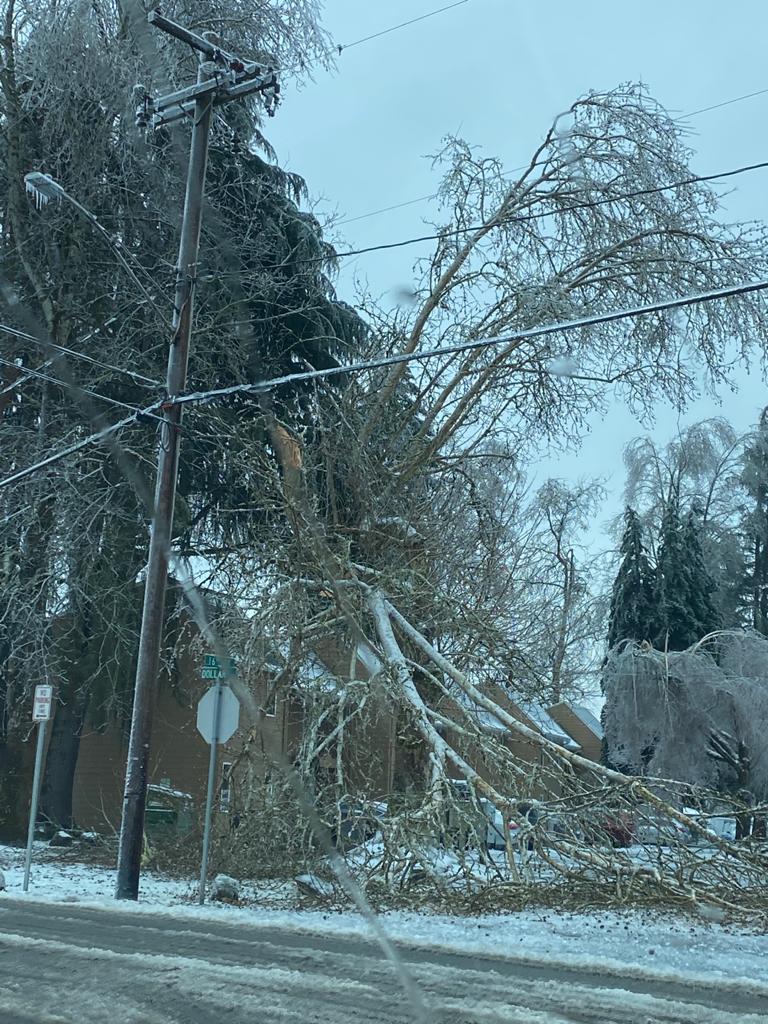On Feb. 11 Oregon residents across the Willamette Valley/Portland Metro area braced for a “Winter Storm Warning” which evolved into a severe ice storm, resulting in power outages for more than 300,000 people. Some residents were left without power for more than four days (and counting). By the end of Feb. 13, a moderate accumulation of snow was completely covered in one to three inches of solid ice. A further “Ice Storm Warning” was issued for Sunday and Monday, as temperatures remained below freezing and more precipitation (in the form of freezing rain) loomed.
As power outages spread, Oregon Gov. Kate Brown declared a state of emergency in nine counties. Outages affected residential and commercial areas alike, leaving many grocery stores with no refrigeration. One Kroger-owned chain made local headlines after managers called the police to guard an industrial dumpster full of discarded packaged meat, cheese, juice, and frozen foods from mutual aid volunteers who were attempting to salvage food to feed the hungry. (OregonLive.com)
Energy company reacts to unprecedented outages

Ice storms, which are common during Portland-area winters, are particularly dangerous for their profound and unpredictable effect on electric power systems. Ice forms on trees, weighing down their needles and branches, often causing them to pull down power lines, or to crack power poles, decommissioning entire sections of cables and blocking roads. Some neighborhoods have been boxed-in by downed trees and power lines. Ice also forms on the power lines, transformers, and substations themselves, causing them to twist, bend, and break. What seems like green lightning during an ice storm is actually transformers blowing; what sounds like thunder is just the pops and crashes of trees splitting apart and striking cars, buildings and pavement.
An ice storm can render roads completely impassable, covered in black ice and debris for several days, making it dangerous and unwise for clean-up and repair crews to visit the affected areas until temperatures rise enough to melt the ice.
Crews from Washington, Nevada, Idaho and Montana have been recruited to assist with repairs across Oregon. And still, depending on location, and the number of people without power in your area, the reply from the power company might be, “You’ll have to wait.”
The unprecedented impact of this storm overwhelmed PGE, the Portland General Electric company, (which serves roughly 1.8 million Oregonians across seven counties, or 44% of the state’s population) preventing them from making accurate estimates of when power would be restored. For some residents, PGE said they could be without power (heat, light, internet, hot water, cooking appliances and even clean water) for 14 days.
In a pandemic winter, when the risk of spreading COVID-19 between households is high, neighbors have had to take the risk to help each other by sharing generators, firewood, food, cooking equipment, clean water and more. Thousands of families now affected by this storm are still displaced and living in temporary shelter after the wildfires that consumed Clackamas County last fall. How are those families faring now as they experience yet another crisis?
The profit motive vs. utilities for the people
Portland General Electric company, an energy company formerly owned by the disgraced and criminal Enron corporation, lost $104 million in 2020 by betting on price swings in California’s energy market. Investors at PGE bet on California rates remaining low, but when wildfires erupted across the state and energy rates skyrocketed, they faced huge losses. The profit motive often prevents energy companies from making intelligent decisions, and they instead favor anything that will keep costs low and profits high.
Companies argue that major repairs or overhauls like burying power lines are too costly. But this is only an issue because energy providers are private companies subject to the judgment of stockholders and speculators. If energy was provided by a public, democratically-run utility, improvements to the safety and longevity of the energy system would be considered necessary infrastructure investment, not a debate over profits.





